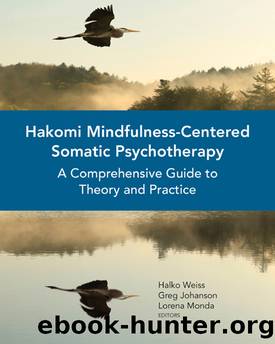Hakomi Mindfulness-Centered Somatic Psychotherapy_A Comprehensive Guide to Theory and Practice by Halko Weiss & Greg Johanson & Lorena Monda

Author:Halko Weiss & Greg Johanson & Lorena Monda [Weiss, Halko & Johanson, Greg & Monda, Lorena]
Language: eng
Format: epub
Tags: Self Help, Psychology
ISBN: 9780393710724
Google: Qw2dBAAAQBAJ
Amazon: 0393710726
Goodreads: 23316560
Publisher: W. W. Norton Company
Published: 2015-05-25T00:00:00+00:00
CHAPTER 19
Working Through Core Beliefs
Manuela Mischke Reeds
IN TRADITIONAL PSYCHOANALYTIC work, âworking throughâ refers to âthe process of having the client face the same conflicts over and over again, under the analystâs supervision, until he can independently face and master the conflicts in ordinary lifeâ (English & English, 1958, p. 591). In Hakomi therapy, working through is a specific stage in the therapeutic process, called the processing phase, in which the client experiences and processes core material. âCore materialâ refers to the beliefs that the clientâs soma-psyche organizes around (Johanson, 2015). Core beliefs are often unconscious or in implicit memory (Schacter, 1992) and have a powerful impact on how a person perceives and automatically reacts to the world and relationships, giving rise to the conflicts suggested in the definition above (Chapter 7). For instance, a belief that support cannot be trusted can lead to interpersonal clashes when genuine support is offered by a friend or partner but then refused. Core organizing beliefs are often unearthed through the techniques and interventions previously outlined in this section.
Many psychotherapeutic approaches acknowledge the significance of core beliefs, but how they are worked through differs. The Hakomi orientation approaches core organizers through inviting a shift to a mindful state of consciousness, so that clients can notice and study how their core beliefs automatically affect their perception and expression (Weiss, 2008). The state-specific learning that occurred when these habits and beliefs first formed needs to be accessed through mindfulness (Baer, 2003; Brown et al., 2007) or we risk remaining at the mercy of an already-organized ordinary consciousness. This slowed-down, contemplative, or self-reflective state enables clients to experience themselves in a deeper, more truthful way (Chapter 10). At this stage in the process, the therapist trusts that if clients can experience these beliefs safely and directly, then resources or gifts from the unconscious can surface and offer expanded choices in contrast to the choicelessness or automaticity (Bargh & Chartrand, 1999) of the limiting belief systems.
In the working-through phase, clients encounter the limitations of their core beliefs both emotionally and sensorially, as well as the formative experiences that lie behind them. This experiential process brings up their grief and pain, as well as offering them insight into why these core beliefs are operating. In this phase, clients somatically experience that these limitations have produced important survival-level strategies, appropriate at the time of their conception (Chapters 8 and 23), but at the price of narrowing their options in the present. When these beliefs are experienced and transformed, clarity of mind and somatic understanding can arise, along with negotiating barriers (Chapter 17) to fuller possibilities in life.
Download
This site does not store any files on its server. We only index and link to content provided by other sites. Please contact the content providers to delete copyright contents if any and email us, we'll remove relevant links or contents immediately.
The Art of Thinking Clearly by Rolf Dobelli(10230)
The 5 Love Languages: The Secret to Love That Lasts by Gary Chapman(9600)
Mindhunter: Inside the FBI's Elite Serial Crime Unit by John E. Douglas & Mark Olshaker(9206)
Becoming Supernatural by Dr. Joe Dispenza(8126)
Nudge - Improving Decisions about Health, Wealth, and Happiness by Thaler Sunstein(7622)
The Road Less Traveled by M. Scott Peck(7524)
Enlightenment Now: The Case for Reason, Science, Humanism, and Progress by Steven Pinker(7239)
Mastermind: How to Think Like Sherlock Holmes by Maria Konnikova(7229)
Win Bigly by Scott Adams(7095)
The Way of Zen by Alan W. Watts(6509)
Factfulness: Ten Reasons We're Wrong About the World – and Why Things Are Better Than You Think by Hans Rosling(4694)
The State of Affairs by Esther Perel(4644)
Gerald's Game by Stephen King(4584)
Man's Search for Meaning by Viktor Frankl(4430)
The Confidence Code by Katty Kay(4189)
Thinking in Bets by Annie Duke(4154)
The Healing Self by Deepak Chopra(3476)
Hidden Persuasion: 33 psychological influence techniques in advertising by Marc Andrews & Matthijs van Leeuwen & Rick van Baaren(3475)
The Worm at the Core by Sheldon Solomon(3436)
